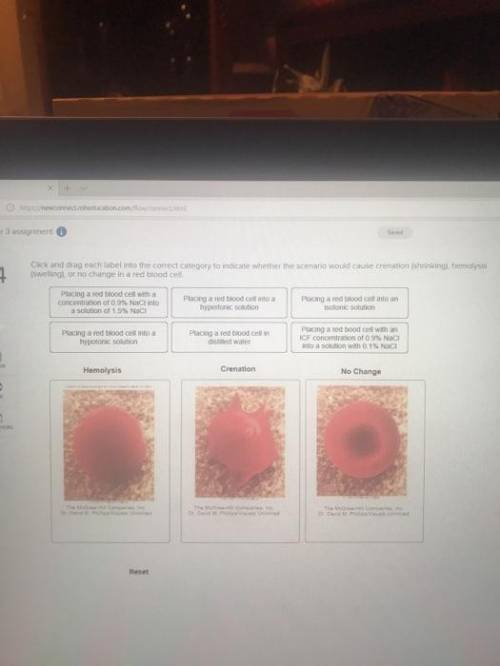
Medicine, 12.02.2020 00:55 teamroper35
Click and drag each label into the correct category to indicate whether the scenario would cause crenation (shrinking), hemolysis (swelling), or no change in a red blood cell.

Answers: 1


Another question on Medicine

Medicine, 03.07.2019 13:10
What is the general location and primary function of occipital lobe?
Answers: 1

Medicine, 09.07.2019 20:10
Rita schmidt, 74 years of age, is a female patient who was admitted to the surgical unit after undergoing removal of a section of the colon for colorectal cancer. the patient does not have a colostomy. the patient has several small abdominal incisions and a clear dressing over each site. the incisions are well approximated and the staples are dry and intact. there is a jackson-pratt drain intact with minimal serous sanguineous drainage present. the patient has a salem sump tube connected to low continuous wall suction that is draining a small amount of brown liquid. the patient has no bowel sounds. the foley catheter has a small amount of dark amber-colored urine without sediments. the patient has sequential compression device (scd) in place. the nurse performs an assessment and that the patient's breath sounds are decreased bilaterally in the bases and the patient has inspiratory crackles. the patient's cardiac assessment is within normal limits. the patient is receiving o2 at 2 l per nasal hg; heart rate 110 bpm; respiratory rate 16 breaths/min; and the patient is afebrile. the patient is confused as to place and time. cannula with a pulse oximetry reading of 95%. the vital signs include: blood pressure, 100/50 mm. a. explain the assessment parameters used to provide clues to detect postoperative problems early and the interventions needed. b. what gerontological postoperative considerations should the nurse make?
Answers: 3

Medicine, 09.07.2019 20:10
Mr. wayne is a 38-year-old man with a significant history of elevated cholesterol levels. his father died at age 42 from a massive heart attack secondary to elevated cholesterol and triglycerides, and two of his older siblings are currently taking medications to lower their cholesterol levels. mr. wayne makes an appointment to discuss his risk for hypercholesterolemia. the nurse recognizes that mr. wayne is at risk for familial hypercholesterolemia because this is an autoomal dominant inherited condition. a. describe the pattern of autosomal dominant inheritance. b. mr. wayne asks what chance his children have of developing familial hypercholesterolemia. how should the nurse respond? c. explain the phenomenon of penetrance observed in autosomal dominant inheritance.
Answers: 1

Medicine, 09.07.2019 20:20
Which of the following is an example of airborne transmission? a. sneezing by an infected person not covering his mouth b. acquiring a disease from an insect bite c. fomites, such as hospital bedding and linen d. inanimate objects, such as medical equipment and supplies
Answers: 2
You know the right answer?
Click and drag each label into the correct category to indicate whether the scenario would cause cre...
Questions


Chemistry, 26.10.2021 07:30


History, 26.10.2021 07:30



Geography, 26.10.2021 07:30

Mathematics, 26.10.2021 07:40

Mathematics, 26.10.2021 07:40






History, 26.10.2021 07:40

Computers and Technology, 26.10.2021 07:40

History, 26.10.2021 07:40



Mathematics, 26.10.2021 07:40




